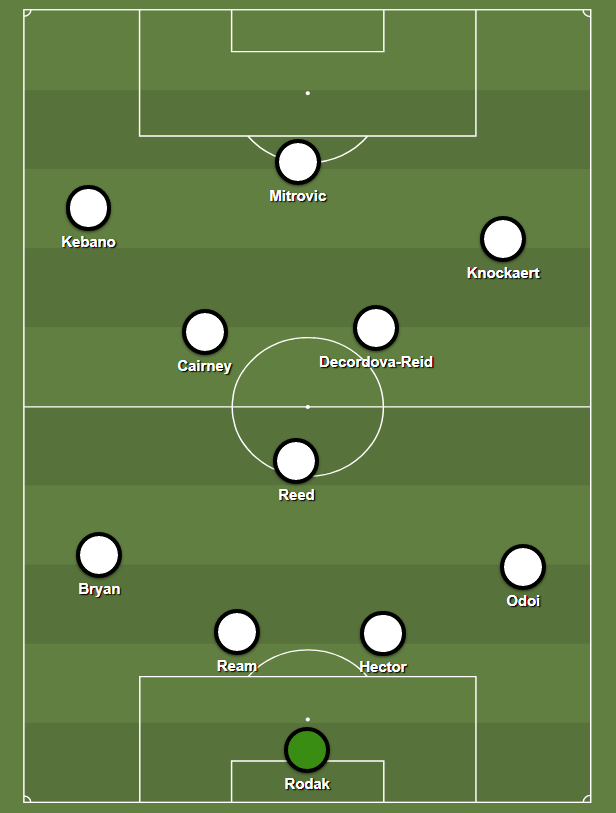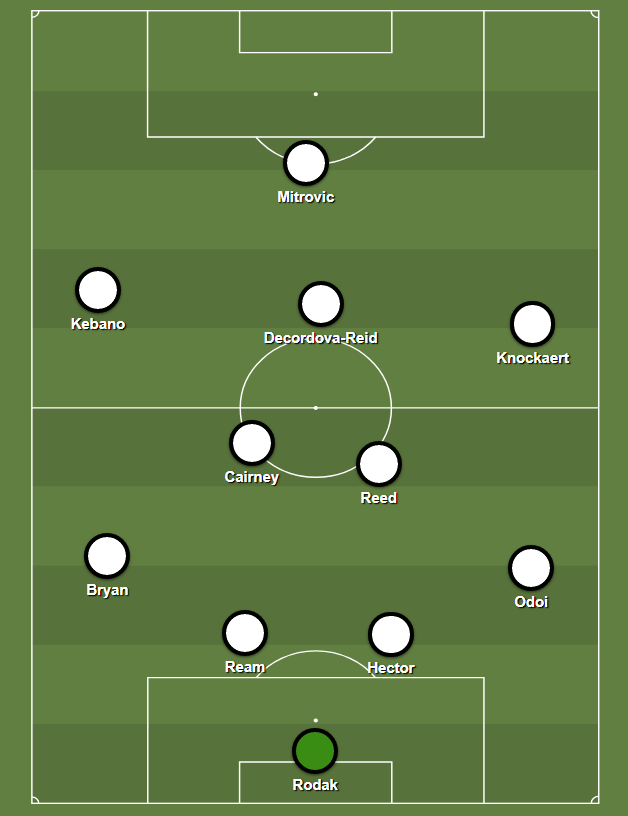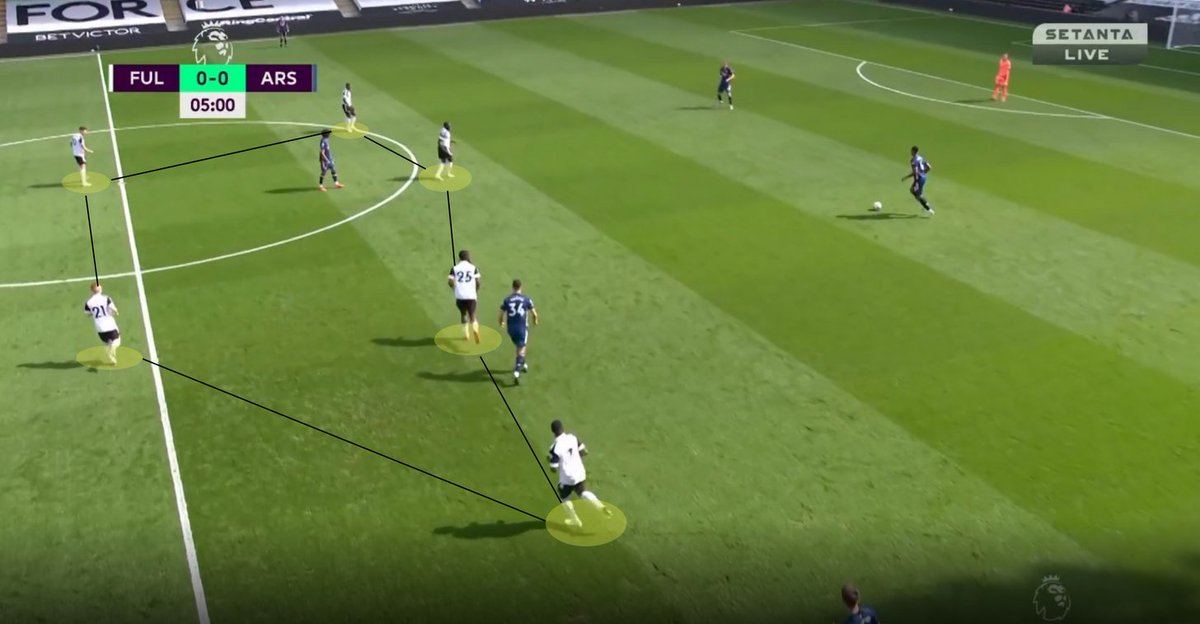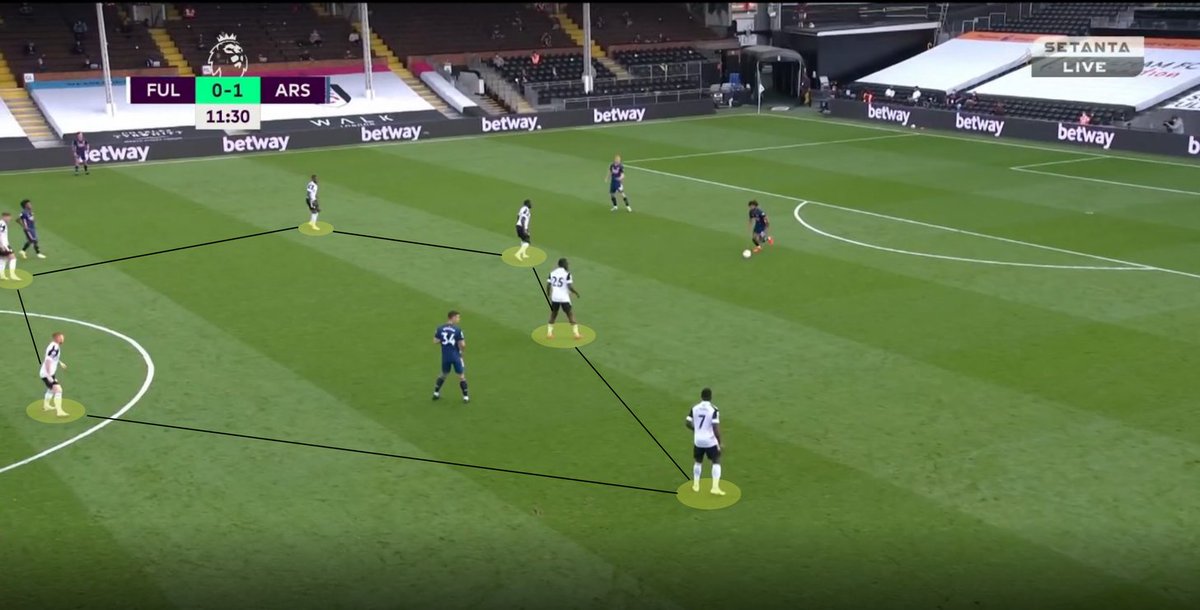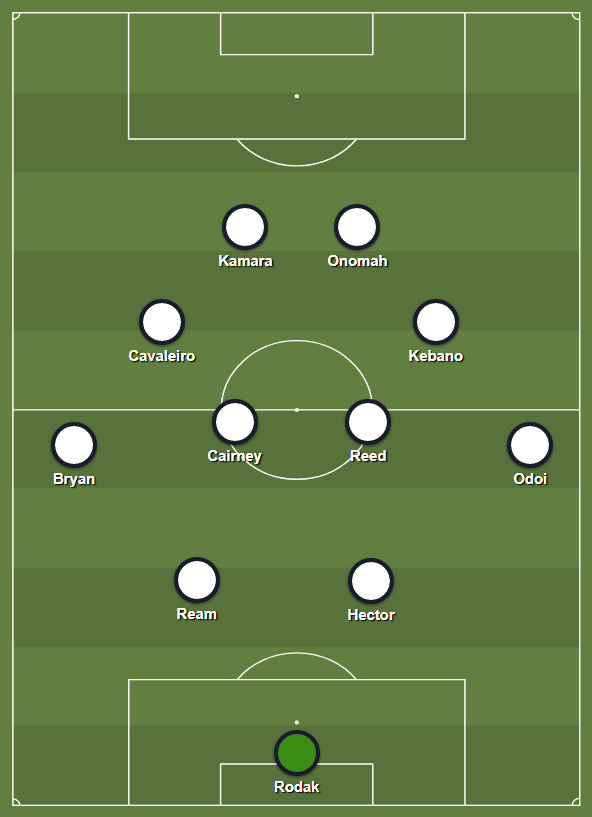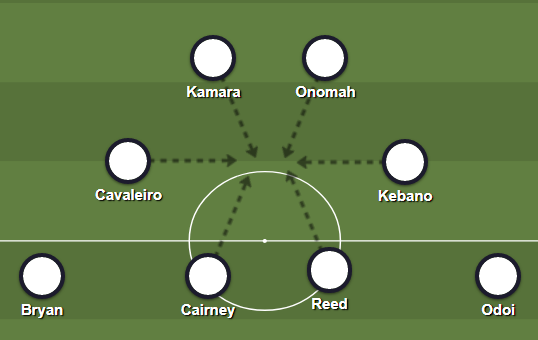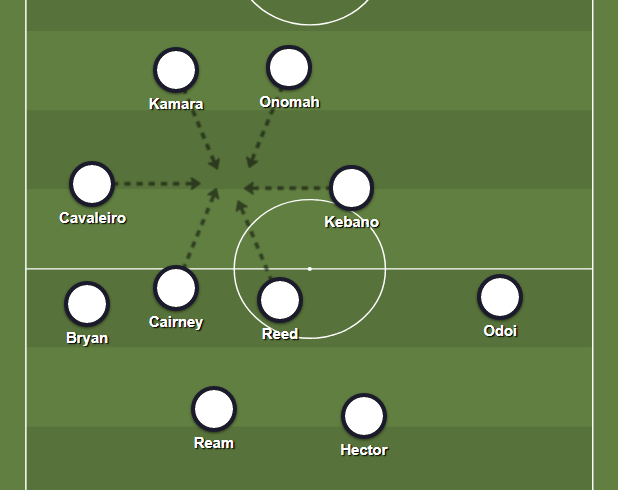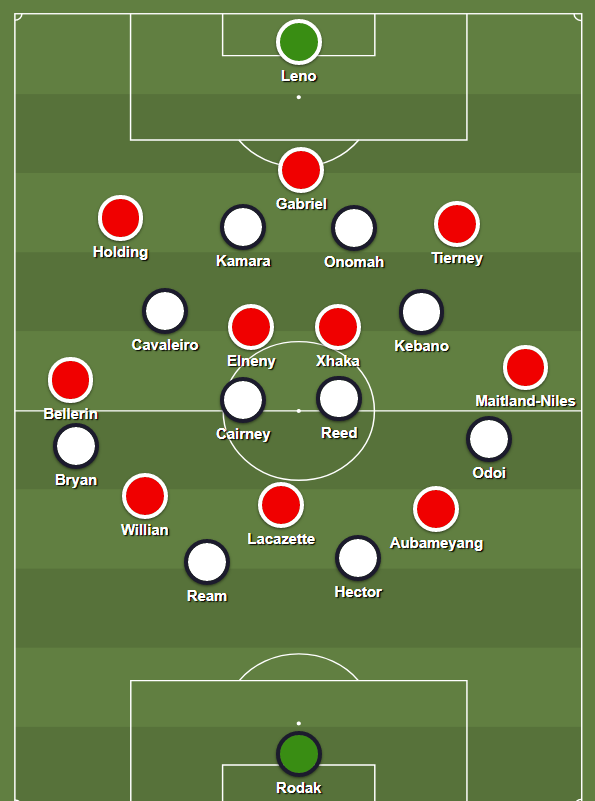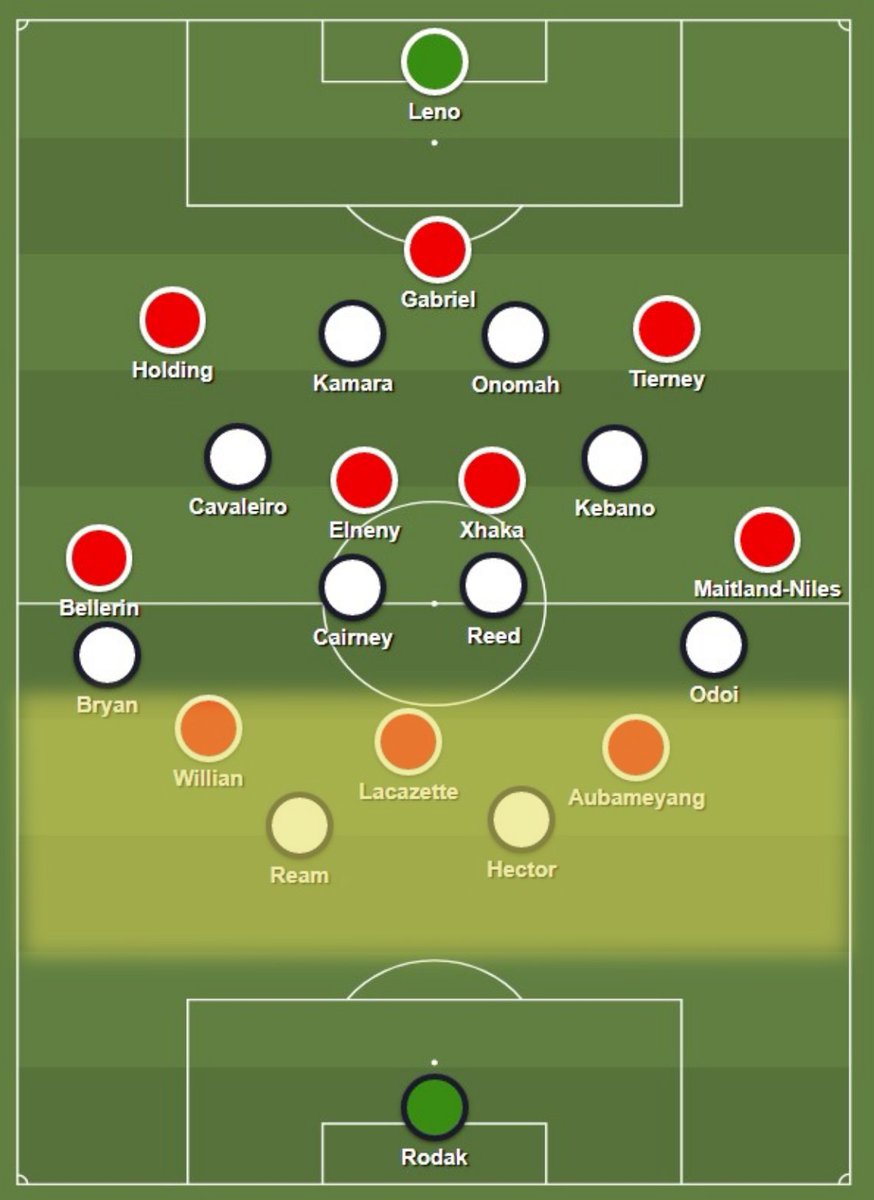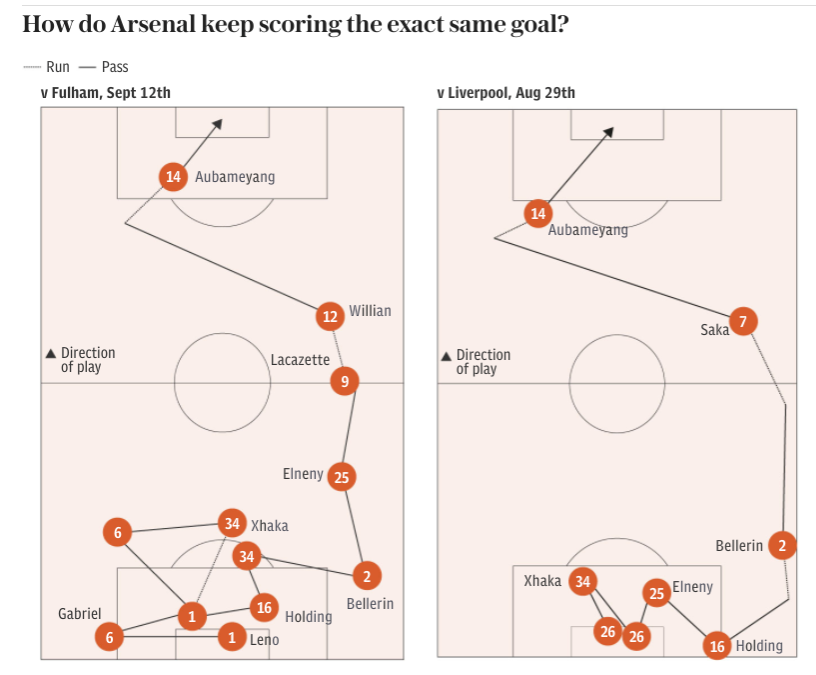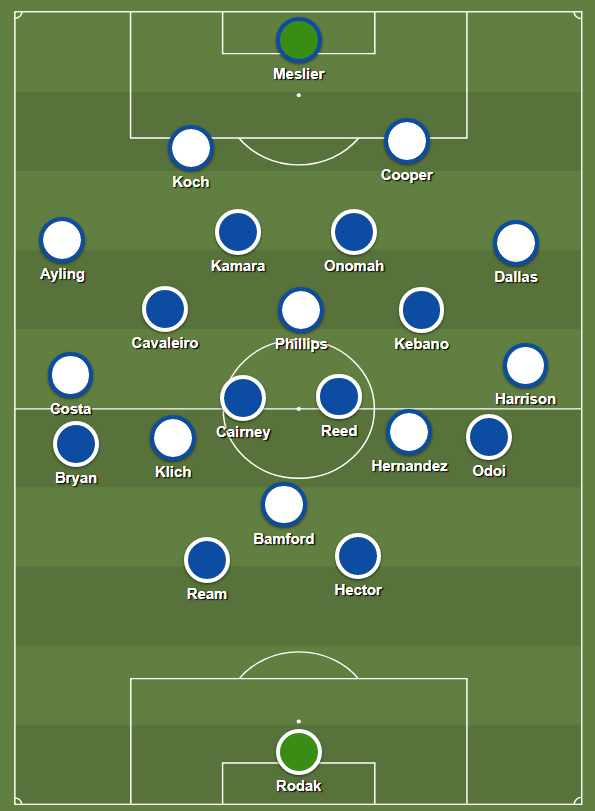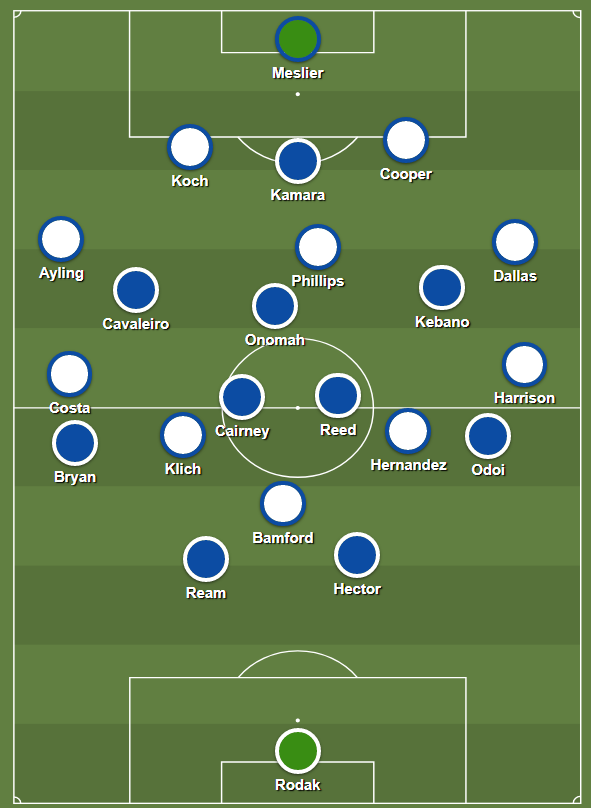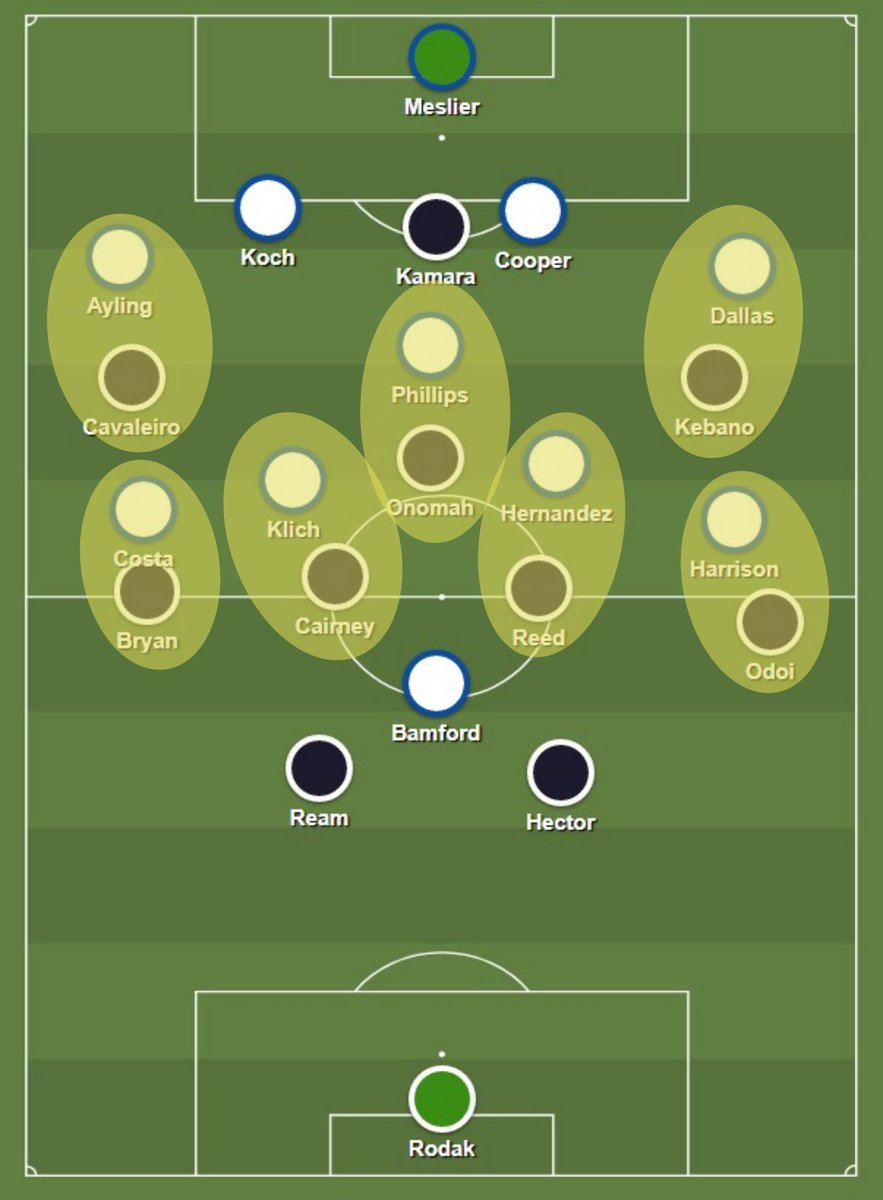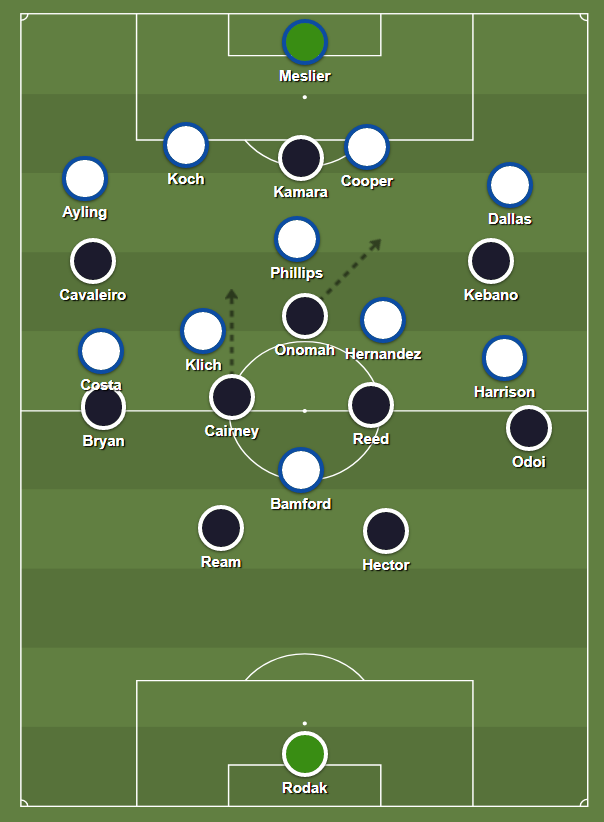Some tactical thoughts on Leeds’ game against Fulham on Saturday afternoon #lufc: [thread]
It feels like I spend my life writing about Fulham’s tactics under Scott Parker. This is the third one of these threads I’ve written in the last year.
In the past, I’ve been pretty critical of ‘Scotty’. At times, his Fulham side in the Championship was turgid. He managed to take what was one of the best squads in the division and had them out playing snore-fest football.
Having watched their game with Arsenal a couple of times over, though, I am about to make a shocking volte-face: Parker’s Fulham aren’t as bad as they used to be.
This is, however, a caveat: in possession, they still looked as ponderous as ever - there was still the interminable build-up play that ends with them trying to get the ball into a forward from wide… which is fine.
But out of possession, they’re actually quite… fun?
Last season, Fulham set up in a 4-3-3 with a fairly fluid midfield three:
Last season, Fulham set up in a 4-3-3 with a fairly fluid midfield three:
This season, Parker seems to have taken a different approach altogether. Here’s a couple of screengrabs from their game at the weekend:
As you can see, although Fulham lined up in a fairly bog-standard 4-2-3-1 on paper, out of possession they formed a 4-2-2-2 with their forward players in a hexagon. With their wide players tucking in and Josh Onomah and Aboubakar Kamara lining up alongside one another.
Why might you approach your out-of-possession phases like this?
Well, we know that Fulham like to engage a high press. In our home game against them in June, they pressed us fairly well in high areas.
Well, we know that Fulham like to engage a high press. In our home game against them in June, they pressed us fairly well in high areas.
The 4-2-2-2 is often used in Germany by teams who like to engage in a high pressing approach. For example, under Ralf Rangnick and Ralph Hasenhuttl, RB Leipzig used this set up to great effect in their first season in the Bundesliga.
Look at Fulham’s structure out of possession:
Look at Fulham’s structure out of possession:
As you can see, that hexagon shape keeps the forward players relatively close together. This aids the press by creating a ring which allows the players to swarm the ball:
Of course, this compactness can lead to structural problems. The pressing pack needs to move as a unit and follow the ball which means there can be a lot of lateral movement:
Obviously this opens up space over on the ball-far side of the pitch. In the scenario above, Dennis Odoi ends up having to cover a huge tract of space to make up for this.
The question is then: why would you play this way against Arsenal?
The question is then: why would you play this way against Arsenal?
This is not an easy question to answer. No doubt Parker thought that the switch to an out-and-out double pivot would give a little bit more coverage to his centre backs - this is the Premier League after all not the Championship.
But the 4-2-2-2 actually gives a nice structure with which to press the 3-4-3 that Mikel Arteta opted to go for:
As you can see, the hexagon of the 4-2-2-2 rings around the two Arsenal central midfielders, cutting them off from their teammates in the build-up phase.
The Fulham wide players can push out to the outside centrebacks easily enough if the ball goes to them and the Fulham full backs can push up to the Arsenal wing backs should Arsenal choose to go wide.
Should Arsenal find their central midfielders, Cairney and Reed can quickly pressure them.
So where’s the downside? Every tactic has an equal and opposite downside. For Fulham, the downside comes from the narrowness of their out-of-possession structure and the risk of leaving their centre backs and ball-far full back to track Arsenal’s front three:
Of course, the obvious response to this was that, on the face of it, Fulham coped relatively well with the structural deficiencies of this system. The first goal came from a six-yard-box scramble and the second from a corner.
The third did, it must be said, come from exploiting the width issue. However, Arsenal have been overloading to isolate with regularity under Arteta and Aubameyang is elite. If he can do it against Liverpool, he can do it against Fulham:
However, the Fulham centre backs looked exposed all through the game, leading a lot of Fulham fans questioning whether or not Michael Hector and Tim Ream are suited for life in the Premier League.
In fact, it was probably the case that it was Fulham’s attacking play that let them down. StatsBomb has Fulham only creating 0.2 xG during the game which is obviously a cause for concern.
We’ve already mentioned how their possession-heavy build-up isn’t incisive enough and Parker will have to do something this season if he wants his side’s in-possession performance to match up to their out-of-possession performance.
How does this apply to the weekend’s fixture?
In many respects, this is a tricky one. Will Fulham go back to their 4-3-3 that caused us - let’s be honest - some problems in possession in the first half of the game back in June?
I suspect the answer to this is maybe not because of structure again. Let’s look at how Leeds will fit into the 4-2-2-2 defensive structure that Fulham put up against Arsenal:
As you can see, the ringing structure that typifies the 4-2-2-2 doesn’t make much sense against the 4-1-4-1 of Leeds. Only Kalvin Phillips is covered by the hexagon and the back four can fold around it and render it largely inefficient.
With the wide attacker, the full back, the ball-near 8 and Kalvin Phillips all able to work the ball around on either side, this structure would largely facilitate Leeds’ build-up
and the option of a switch would always be on, putting Jack Harrison up against Dennis Odoi or Michael Hector.
But whether that means they will go back to the 4-3-3 is up for debate. If they’re playing 4-2-3-1 in possession in the Premier League and they were playing that out of possession in the Championship with Cairney dropping back,
it seems most likely that they will stick with the 4-2-3-1 and then they have the option of the 4-3-3 in possession if they need.
Here, you can see that the 4-2-3-1 makes much more sense out of possession - the wide players can stay wide in defensive situations to help break up Leeds’ build-up play and the 10 can put pressure on Kalvin Phillips - the fulcrum of Leeds’ build-up.
(Expect to see Mitrovic brought in to play the lone striker in this instance.)
One of the other weaknesses in the 4-2-2-2 out of possession is that in attacking transition, it often felt like Fulham weren’t getting enough players forward. The 4-2-3-1/4-3-3 hybrid would help that:
As you can see, the 4-2-3-1 allows good coverage of the Leeds 4-1-4-1 - the midfields match up and the two wide players can watch the full backs. The lone striker can then press the ball-near centre back.
In addition, this out-of-possession structure allows Fulham to decompress in a way that allows them to attack the spaces that Leeds’ structure will open up:
As you can see here, with Fulham in possession, the midfield three can rotate around so that Onomah pulls Kalvin Phillips out of the middle, leaving space for Cairney to attack. Harrison Reed can then sit in behind and cover the defence.
This would also aid Fulham’s build-up play by opening passing lanes centrally which would give their attacking play much more scope. From there, they could help work the ball into wide areas or, alternatively, threaten much more through the central spaces than they usually do.
In the opposite dugout, Marcelo Bielsa will be hoping for his team to have much more fruitful build-up play than they did against Liverpool.
Although Leeds did enjoy a greater share of the possession at Anfield, their build-up wasn’t as structured as usual and so we saw a relatively frequent change of possession backwards and forwards between the two sides.
Bielsa will want his side to transition through the Fulham press so that they can then attack the Fulham defence in behind. Josh Hobbs has just written a medium piece exploring how this happened against Liverpool: https://medium.com/@allstatsarentwe/will-leeds-use-of-wingers-be-key-to-their-attack-in-the-premier-league-ba09feb056a1">https://medium.com/@allstats...
This was how Leeds scored all three of their goals against Fulham at Elland Road in June.
Marcelo Bielsa and Scott Parker have faced each other enough times now that they will know their strengths. This match is complexified by the fact that the game is now a potential relegation battle rather than a promotion battle.
Scott Parker has his team well-drilled off the ball. But as we know, this isn’t likely to be enough against Leeds. If Fulham can create chances, they may be in with a chance. But if they can’t, there may be questions asked of Parker’s tenure at the club.
If you prefer this thread in blog form: https://allstatsarentwe.substack.com/p/leeds-united-vs-fulham-a-tactical-dda/comments">https://allstatsarentwe.substack.com/p/leeds-u...
If you want to listen to our Fulham Preview podcast epidsode: https://pod.fo/e/9b999 ">https://pod.fo/e/9b999&q...
If you like our content and want more, check out our Patreon channel: http://www.patreon.com/allstatsarentwe ">https://www.patreon.com/allstatsa...
If you& #39;ve made it this far, why not be a lovely person and share the original tweet in this thread?

 Read on Twitter
Read on Twitter